|
Finding the Way in the Age of Sail
by
Bob Brooke
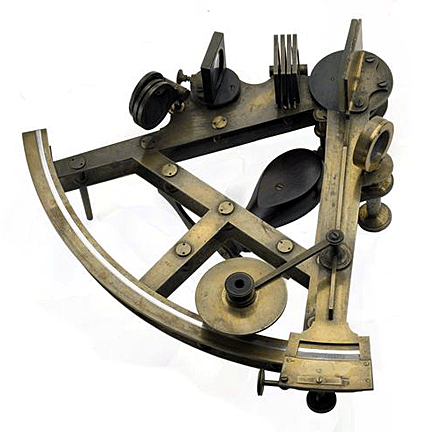 Leaving
port a ship heads out to sea. Land vanishes from site over the horizon.
For days or weeks she sails on the trackless ocean. Passages held great
peril, even for well-built ships under experienced shipmasters. Storm,
fog, illness, accident, damage to the vessel or even shipwreck could
bring death far from home. Vessels were known to vanish without a trace. Leaving
port a ship heads out to sea. Land vanishes from site over the horizon.
For days or weeks she sails on the trackless ocean. Passages held great
peril, even for well-built ships under experienced shipmasters. Storm,
fog, illness, accident, damage to the vessel or even shipwreck could
bring death far from home. Vessels were known to vanish without a trace.
If a ship was to arrive safely at its destination, it was essential for
the captain to calculate its position, using navigational tools such as
the wet compass for determining direction, the chronometer for
determining longitude, the sextant for calculating latitude, and the
spyglass.
Early Nautical Instruments
Perhaps the earliest navigational instrument was the astrolabe, an
instrument used for measuring the positions of heavenly bodies. It
consisted of a circle or section of a circle,
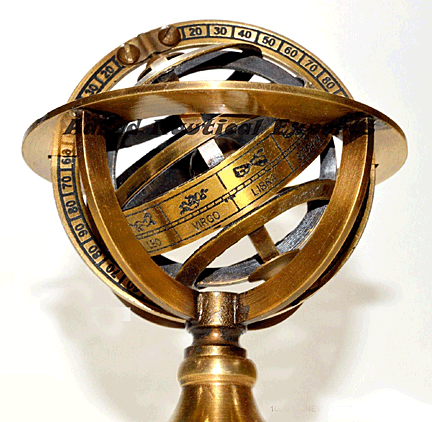 marked
off in degrees, with a movable arm pivoted at the center of the circle.
When a sailor oriented the zero point on the circle with the horizon, he
could determine the altitude of any celestial object by sighting along
the arm. While the astronomer's astrolabe was complex, a mariner’s
astrolabe was much simpler. It was also heavier to keep it vertical on
the rolling deck of a ship. Introduced about 1460, it didn’t come into
general use until the beginning of the 16th century. Mariners continued
to use it until after 1670, particularly by the Spanish and Portuguese,
who used it until the early 18th century. marked
off in degrees, with a movable arm pivoted at the center of the circle.
When a sailor oriented the zero point on the circle with the horizon, he
could determine the altitude of any celestial object by sighting along
the arm. While the astronomer's astrolabe was complex, a mariner’s
astrolabe was much simpler. It was also heavier to keep it vertical on
the rolling deck of a ship. Introduced about 1460, it didn’t come into
general use until the beginning of the 16th century. Mariners continued
to use it until after 1670, particularly by the Spanish and Portuguese,
who used it until the early 18th century.
Among the more decorative and probably the earliest of nautical items
are the compasses which enabled ships to navigate with some degree of
certainty in daylight and when stars weren’t visible. The first use of a
ship's compass dates from the 12th century. Although medieval compasses
are extremely rare, German instrument makers began producing boxed
compasses by the 16th Century.
The Mariner’s Compass
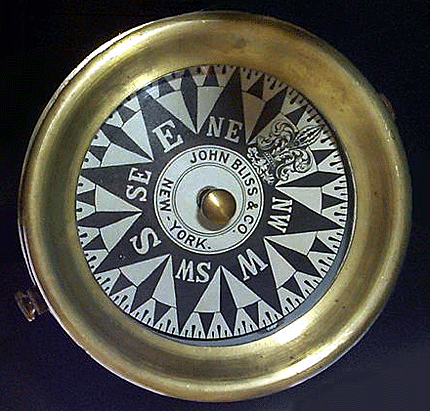 Eighteenth
and nineteenth mariners used two types of compass—the dry card or
magnetic and the liquid or gyrocompass. In the former, magnetic needles
point in the general direction of the north magnetic pole. The latter
consisted of a bowl filled with a liquid, usually a mixture of alcohol
and water, which reduced friction and lessens vibrations. Since the
gyrocompass wasn’t subject to the deviation and variation of the
magnetic compass, it was ideal for use on a sailing vessel. The compass,
housed in a case called a binnacle, usually stood near the wheel of a
sailing ship. Eighteenth
and nineteenth mariners used two types of compass—the dry card or
magnetic and the liquid or gyrocompass. In the former, magnetic needles
point in the general direction of the north magnetic pole. The latter
consisted of a bowl filled with a liquid, usually a mixture of alcohol
and water, which reduced friction and lessens vibrations. Since the
gyrocompass wasn’t subject to the deviation and variation of the
magnetic compass, it was ideal for use on a sailing vessel. The compass,
housed in a case called a binnacle, usually stood near the wheel of a
sailing ship.
Until the early 18th Century, a mariner's navigation consisted of
“shooting the sun” to determine latitude and dead reckoning–where the
ship actually was--coupled with piloting, to estimate the longitude.
The Search for Longitude
The increased activity in "the search for longitude" also spurred
innovative interest in other areas of navigation. In 1731, John Hadley,
an British mathematician demonstrated his new reflecting quadrant to
fellow members of the Royal Society in London. He based his
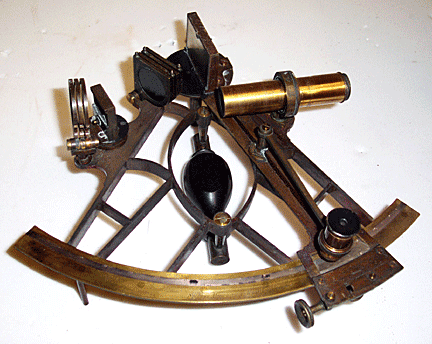 quadrant
on the principle of light reflection and angles of incidence described
by Robert Hooke, Isaac Newton, and Edmund Halley nearly a century
earlier. The principle is that when an object is seen through a double
reflection its angle from the eye is twice the angle between the
reflecting surfaces. Thus Hadley's quadrant, reading to 90 degrees,
actually required an arc of only 45 degrees, one eighth of a circle, or
an "octant." quadrant
on the principle of light reflection and angles of incidence described
by Robert Hooke, Isaac Newton, and Edmund Halley nearly a century
earlier. The principle is that when an object is seen through a double
reflection its angle from the eye is twice the angle between the
reflecting surfaces. Thus Hadley's quadrant, reading to 90 degrees,
actually required an arc of only 45 degrees, one eighth of a circle, or
an "octant."
Hadley’s instrument consisted of a triangular wooden frame with a
swinging index arm pivoted at the apex. He fixed a mirror at that point
which would move with the arm. He fixed a second mirror, half of which
was transparent, to one limb with the sight attached to the opposite
limb. Finally, he scribed a precise scale, calibrated in degrees, on the
arc of the bottom limb of the triangle, across which the index arm
moved. Hadley’s invention eventually became known as the sextant.
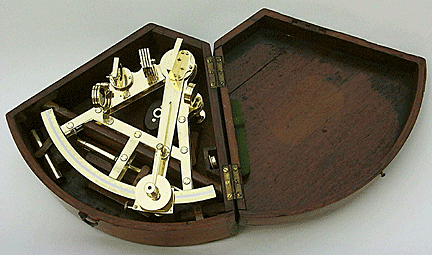
The superiority of the sextant in terms of accuracy, compactness, and
durability was indisputable. The last half of the 19th century saw
little change in navigational instruments in general and the sextant in
particular. Since a good sextant could last 50 years, there was little
incentive for improvement in its manufacture or design.
Other Nautical Instruments
In 1735, John Harrison, a British carpenter, successfully constructed
the first marine chronometer having some components of wood and weighing
125 pounds! Because of its precise timekeeping ability, the chronometer,
in perfected form, later became an indispensable addition to nearly
every ocean-going vessel.
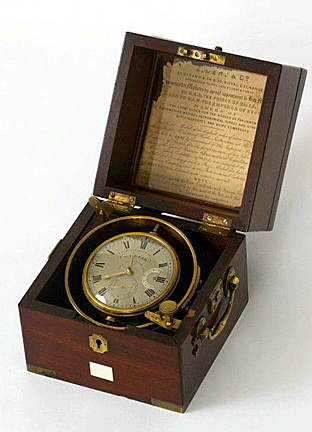 An
early version of the slide rule, the Gunta’s Scale, used logarithms and
other scales to assist in numeric and trigonametirc calculations.
Instead of using a sliding scale to assist in the addition and
subtraction of logarithms, it used dividers to mark sums and
differences. Some of its scales help solve the problems of dead
reckoning. An
early version of the slide rule, the Gunta’s Scale, used logarithms and
other scales to assist in numeric and trigonametirc calculations.
Instead of using a sliding scale to assist in the addition and
subtraction of logarithms, it used dividers to mark sums and
differences. Some of its scales help solve the problems of dead
reckoning.
A Walker’s Harpoon ship log was a mechanical log that told the distance
a ship sailed
by recording the number of times a section of the machine turned. An
indicator showed nautical miles sailed in hundreds, tens, and ones. A
crewman dropped the log overboard when a ship sets sail and hauls it in
for readings. Though it was imperfect due to mechanical losses and the
unmeasurable effects of waves and ocean currents, a harpoon log was more
accurate than a traditional ship’s log and sand hourglass.
One of the greatest concerns of the nautical instrument makers
throughout history has been accuracy. Because of the severe conditions
and extremes encountered at sea, a poorly constructed instrument was apt
to shrink, expand, warp, or crack rendering a false, and potentially
fatal reading. Instrument makers tried numerous materials and
innovations in an attempt to ensure rigidity and stability of the octant
and sextant.
Materials Used to Make Nautical
Instruments
Around 1760, instrument makers began to use ivory for scales and
nameplates on sextants because of its durability, ease of engraving, and
light color which provided for
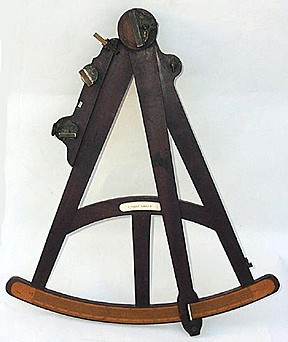 easier
reading. About the same time brass began to replace wood as the
preferred material for the index arm, a trend that would eventually
culminate in the elimination of wooden components altogether. The early
quadrants had large frames, 18 to 20 inches in length, sometimes 24
inches and larger. Because scales had to be calibrated by hand, the
early navigational instruments had to be large since the larger the
instrument the easier the division of the scale. easier
reading. About the same time brass began to replace wood as the
preferred material for the index arm, a trend that would eventually
culminate in the elimination of wooden components altogether. The early
quadrants had large frames, 18 to 20 inches in length, sometimes 24
inches and larger. Because scales had to be calibrated by hand, the
early navigational instruments had to be large since the larger the
instrument the easier the division of the scale.
The more accurate division of the scale and incorporation of a secondary
vernier scale on the index arm, increased accuracy of these instruments
and enabled makers to create smaller, easier-handled instruments.
Manufacturers also added colored glass shades to aid the mariner when
taking his sights in the sun's glare or in hazy conditions. Another
original feature was the "backsight" fitted below the horizon mirror. It
enabled the observer to sight on a celestial object using the opposite
horizon in cases where the fore horizon was indistinct. About 1780 the
introduction of the tangential screw fine adjustment represented the
last major change in the basic operation of the octants and sextants for
the next 150 years.
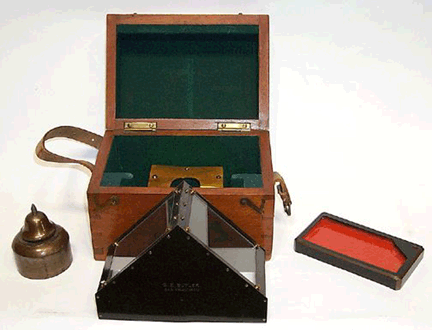 Nautical
historians believe that octant makers used wood for them and brass for
sextants. Although some examples of late 18th-century ebony and ivory
sextants remain, makers produced numerous octants of brass in the mid
19th Century. Quadrants, sextants and octants vary considerably in
complexity, quality of prisms and precision, those incorporating a
telescope being especially desirable. Nautical
historians believe that octant makers used wood for them and brass for
sextants. Although some examples of late 18th-century ebony and ivory
sextants remain, makers produced numerous octants of brass in the mid
19th Century. Quadrants, sextants and octants vary considerably in
complexity, quality of prisms and precision, those incorporating a
telescope being especially desirable.
For the serious nautical collector the astrolabe is perhaps the
ultimate—only 56 survive. But the most popular items are sextants,
octants, chronometers, and, the rarest of all, the highly sought after
ship logs.
<
Back to Antiques Archives
Next Article > |
